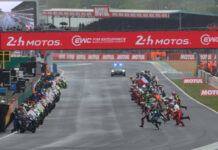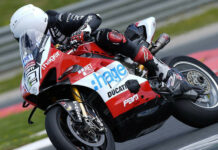USA! USA! USA! 2014 EBR 1190RX Intro JENNINGS, FLORIDA
To read more articles like this May 2014 test ride please subscribe to Roadracing World.
I used to think of Erik Buell’s motorcycles as nice boutique bikes that worked pretty well, but could never truly compete against bikes from the big-volume manufacturers in stock trim. My opinion has changed after riding the new EBR 1190RX. The 2014 1190RX is not only the first genuinely mass-produced model since Erik Buell formed EBR (short for Erik Buell Racing), it also out-performs the more expensive 1190RS both on paper and on the racetrack.
The RX uses the same basic built-in-Wisconsin engine as the RS, a 72-degree, four-valve-per-cylinder V-Twin that displaces 1190cc and has a bore of stroke of 106mm x 67.5mm.
The big news is that improved combustion efficiency in the RX version increased peak power by 10 bhp and torque by almost 5 lbs.-ft. despite a slightly lower compression ratio, 13.4:1 versus 13.6:1, compared to the RS version. (EBR engineers reduced the compression ratio to smooth out the power delivery.) 
The 1190RX engine makes a claimed 185 bhp at 10,600 rpm and peak torque has increased from 97 lbs.-ft. at 9400 rpm to 101.6 lbs.- ft. of torque at 8200 rpm. The increase in combustion efficiency came from EBR’s new Controlled Swirl Induction (CSI) system. The key is offset intake cam lobe centers, opening one of each cylinder’s two intake valves slightly before the other, swirling the intake charge and making it more homogenous, which promotes a better, more complete burn. EBR engineers say the more complete burn also reduces emissions to 75% of the maximum allowed by government regulations.
A new ECU features 21 (1-20, plus Off) levels of traction control in an effort to suit all levels of riding skill along with varying rider weights. The system’s algorithms monitor rpm and throttle position as well as rear wheel speed to determine the amount of rear-wheel slip to remove. Power is removed by reducing ignition advance before phasing in ignition cuts if the system continues to sense too much rear-wheel slip for the selected setting.
The letters TC (which stand for traction control) and the level of traction control selected are always visible on the LCD dash, on the theory that if they weren’t, their sudden appearance when the traction control kicked in would alarm the rider. Instead, the letters flash for three seconds after the system engages to correct a slide, then return to a static display.  Like the RS, the 1190RX has a beefy aluminum-alloy perimeter chassis that doubles as a fuel tank and carries an aluminum-alloy swingarm. Rake angle is 22.4 degrees and the triple clamps have 25mm of offset. That gives the 1190RX 96.5mm (3.8-inches) of trail. Showa BPF (Big Piston Front) forks and a fully adjustable Showa rear shock are used in place of the Öhlins units used on the 1190RS. Like all Erik Buell-designed machines, the 1190RX uses a single front brake disc mounted around the perimeter of the front wheel, along with a large, eight-piston EBR-branded brake caliper. (EBR can’t use ZTL – or Zero Torsional Load – to describe the wheel and brake layout developed by Erik Buell because former Buell Motor Company owner Harley-Davidson retained the name after shutting down its Buell subsidiary in 2009. That’s the same reason why the bike can’t be called a Buell, and instead has to be called an EBR; Harley-Davidson bought the Buell name and won’t give it back.) Hubless cast aluminum-alloy wheels carry Pirelli Diablo Rosso Corsa tires. Claimed weight without fuel is 419 pounds.
Like the RS, the 1190RX has a beefy aluminum-alloy perimeter chassis that doubles as a fuel tank and carries an aluminum-alloy swingarm. Rake angle is 22.4 degrees and the triple clamps have 25mm of offset. That gives the 1190RX 96.5mm (3.8-inches) of trail. Showa BPF (Big Piston Front) forks and a fully adjustable Showa rear shock are used in place of the Öhlins units used on the 1190RS. Like all Erik Buell-designed machines, the 1190RX uses a single front brake disc mounted around the perimeter of the front wheel, along with a large, eight-piston EBR-branded brake caliper. (EBR can’t use ZTL – or Zero Torsional Load – to describe the wheel and brake layout developed by Erik Buell because former Buell Motor Company owner Harley-Davidson retained the name after shutting down its Buell subsidiary in 2009. That’s the same reason why the bike can’t be called a Buell, and instead has to be called an EBR; Harley-Davidson bought the Buell name and won’t give it back.) Hubless cast aluminum-alloy wheels carry Pirelli Diablo Rosso Corsa tires. Claimed weight without fuel is 419 pounds.
My first laps around the JenningsGP circuit were spent getting used to riding a V-Twin again after just spending a weekend racing an Inline Four at Daytona. All the bikes ran well and the base setting was close from the start of the intro day. But the EBR felt a little heavier at turn-in and harder to transition through the esses; it felt a bit top-heavy.
I figured it out when I came back into the pits and started working on refining the set-up. I started by asking the technician assigned to my bike to take two turns of compression damping out of the front forks. That adjustment allowed the forks to ride lower on corner entry and improved the steering. But I was still having a hard time with the EBR pushing wide from the apex to the middle of the corner. I suspected that the rear shock was adjusted to produce too much rebound damping, which limited shock movement. That’s a great way to produce cool slides and reduce shock pump, but bad for turning and tire life.
I came in again and a small, 1/8th- turn rebound adjustment freed up the shock movement. That allowed me to pull the bike down to the apex and get on the gas without it pushing wide at the exit. When I was done experimenting, the settings were surprisingly close to the standard track settings found in the owner’s manual. The techs had changed them based on what they thought would better suit my weight and riding style.
Albeit small, the setting changes transformed the bike, allowing me to focus on really riding hard. JenningsGP isn’t a hard-braking circuit compared to most, so the perimeter braking system was not really put to the test. It did, however, offer good lever feel through the braking zone. The 1190RX was still a little heavy at turn-in and a little slow to transition, but that’s one of the inherent downsides of the V-Twin engine design. To make the engine fit without increasing the wheelbase, both of the tall cylinders have to be positioned high in the chassis, which raises the center of gravity and reduces agility compared to motorcycles with Inline and V-4 engines.
But once the bike is at full lean, the front end of the 1190RX is stable and gives great feedback. At this point of the turn the 96.5mm of trail is very welcome. That’s the geometry used for both 1190 models, updated from the 27mm offset, 86mm of trail on the previous Buell 1125 models made when Harley-Davidson owned Buell Motor Company.
After the apex and driving out of the corner, the EBR has great feel and produces excellent feedback – I think of it as a connection between the twist grip and the seat. Whatever you call it, it allowed me to get the gas open early and light up the street-spec Pirelli Rosso Corsa rear tire at will. Running around the racetrack on stock street tires also showcased the usability of the EBR Traction Control system.  I started my first session with the TC system set on level 6 of 20, which produced a little too much intervention to suit me. But although it was too high a level of intervention, the cuts were smooth and only mildly intrusive compared to most OEM TC systems. I then came in and backed down the TC to Level 1 – it can’t be adjusted on the fly – and left it there for the remainder of the day. Level 1 was a lot less intrusive than Level 6, allowing me to spin the rear tire while still offering a small safety net in case I got the rear hung out too far, and it took some real effort to get into the ignition cut phase! Even then, the intervention at Level 1 was almost seamless, just enough to get the bike to straighten out and start moving forward again.
I started my first session with the TC system set on level 6 of 20, which produced a little too much intervention to suit me. But although it was too high a level of intervention, the cuts were smooth and only mildly intrusive compared to most OEM TC systems. I then came in and backed down the TC to Level 1 – it can’t be adjusted on the fly – and left it there for the remainder of the day. Level 1 was a lot less intrusive than Level 6, allowing me to spin the rear tire while still offering a small safety net in case I got the rear hung out too far, and it took some real effort to get into the ignition cut phase! Even then, the intervention at Level 1 was almost seamless, just enough to get the bike to straighten out and start moving forward again.
The improved chassis and electronic system performance was complimented by the torquey engine. The EBR’s V-Twin delivers a lot of torque from low in the rpm range, building power smoothly from as low as 5000 rpm. The torque gives the rider options when it comes to how they want to ride the bike. At JenningsGP, the EBR could be lugged out of each corner in third gear or revved up in second gear. I wanted a little more response off the corner so I preferred to use second gear. Out of the corner and onto the straights the EBR felt the best when shortshifted around 9500-10,000 rpm because power delivery signed off well before the 11,500 rpm redline. No matter the situation, the EBR engine felt the happiest when kept between 6000 and 10,000 rpm.
Erik Buell Racing’s 1190RX was impressive on the JenningsGP racetrack. It is the most refined and wellput- together road-going, production Buell or EBR motorcycle I have ever thrown a leg over. The 1190RX holds its own on the racetrack, no excuses required.
Erik Buell may have finally built a motorcycle that can turn his company into a real contender on the racetrack, on the street, and in the showroom.
To read more articles like this May 2014 test ride please subscribe to Roadracing World.







